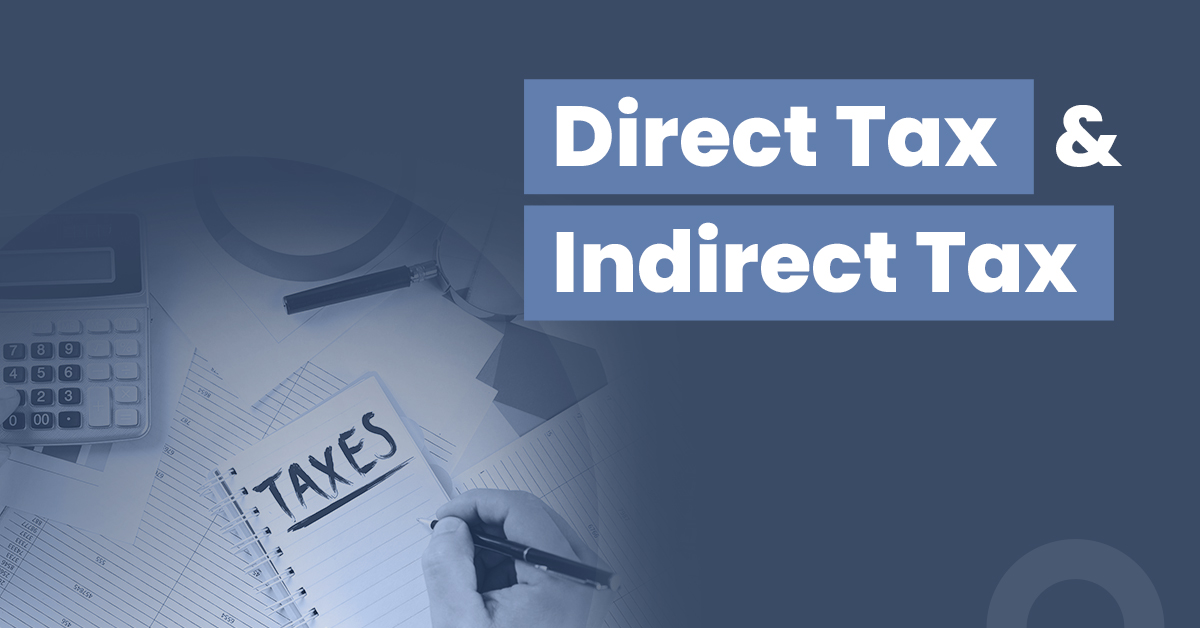Direct Tax and Indirect Tax: 8 Things You Should Know


Taxes are one of the prime sources of revenue for the government. Tax earnings support government operations, such as financing public services. Taxes are collected at various levels like municipal, state, and national.
India’s tax system can be essentially divided into two types: direct tax and indirect tax. This categorisation is based on how the tax payments are collected by the government.
What is Direct Tax?
As the name suggests direct tax is paid directly to the authority responsible for collecting it as it is imposed directly on the taxpayer. These taxes cannot be transferred to any other entity or person. There are several acts which govern direct taxes. For instance, the government levies an income tax, which individuals pay directly to the government.
Direct taxes are administered in India by the CBDT (Central Board of Direct Taxes), which is governed by the Department of Revenue. In addition, the department provides input to the government regarding direct tax implementation.
Also Read: How You Can Plan Capital Gain Tax on Property?
What are the Types of Direct Tax?
These are the various types of direct taxes imposed on citizens of India.
- Income Tax and Capital Gains Tax: Income tax is the most popular kind of direct tax in India. It is the tax that is levied on the income earned by an individual, HUF, LLPs, companies, and local authorities, amongst others throughout a fiscal year.
Whenever an asset like houses, investment properties, bonds, or securities are sold at a price higher than its acquisition price, the income earned is called capital gains and they are taxable. Based on the duration for which the asset is held, the applicable gains are categorised as LTCG (Long-Term Capital Gains) or STCG (Short-Term Capital Gains) and the taxes levied on them are called LTCG tax and STCG tax, respectively. - Securities Transaction Tax: Issued by businesses or the Indian government, securities are tradable investment instruments, including stocks, bonds, debentures, other equity-linked market instruments, etc. The buying and selling of securities listed on Indian stock exchanges is subject to the securities transactions tax irrespective of the gain or loss, which is a direct tax.
- Corporate Tax: Evident from the name, the corporate tax is levied on the profits of the corporations. This direct tax is applicable to both domestic and foreign companies operating in India. The rate of the corporate tax is determined on the basis of turnover.
What is Indirect Tax?
Direct taxes are levied on income and profits, while indirect taxes are levied on goods and services. They are essentially taxes that are imposed on everyone equally, regardless of their income, so whether wealthy or poor, everyone must pay them. The following is a short overview of indirect tax.
The CBIC (Central Board of Indirect Taxes and Customs) is mainly responsible for handling indirect taxes in India.
What are the Types of Indirect Taxes?
Some of the most fundamental types of indirect taxes in India are:
- Goods and Services Tax (GST): GST is a comprehensive, multistage, destination-based tax that has absorbed more than 15 different taxes like Sales Tax, Central Excise, State VAT, and others. There is no longer a cascading tax-on-tax effect as there was under the previous regime. GST is imposed as per the tax slabs decided by the GST council.
- Value Added Tax (VAT): VAT is a kind of consumption tax that must be paid on the sale of certain goods and services. The state government typically imposes VAT, after accessing the cost of a goods/services at each stage of the supply chain like manufacturing, distribution and sale to the final customer. GST has mostly eliminated VAT but it is still imposed on some items.
- Customs Duty: When something is transported over international boundaries, a fee called a customs duty is imposed on it. It is charged on both imports and exports. The purpose of this obligation is to increase government revenue and protect domestic businesses.
- Excise Duty: Excise duty is imposed on commodities produced or manufactured in India and is paid by the companies that make the various products. With the introduction of GST, Excise duty is mostly eliminated. However, it still applies only to Petroleum and Liquor in India.
Basic Differences Between Direct & Indirect Taxes
Having discussed the basics of direct and indirect taxation, here are some fundamental differences between direct and indirect taxes.
- Imposition: An individual’s income and profits are subject to direct taxation. However, not everyone is subject to it; rather only those who are above a particular income level are recognised by the government.
On the other hand, indirect taxes are imposed on goods and services. An intermediary, such as a manufacturer, trader, or service provider, is responsible for collecting indirect tax from the customer. The final financial burden of the tax is transferred to the customer through higher prices. - Applicability: the applicability of a tax implies on which component the tax is levied. A direct tax applies to income and profits, whereas an indirect tax applies to goods, services, and business operations.
- Incidence of the tax burden: The impact of a particular tax on the distribution of economic welfare is known as tax incidence or tax burden. In direct taxation, the tax burden lies directly on the person to whom it is applicable. However, in the case of indirect tax, the burden lies with the participants in the buying and selling process of goods and services.
- Transferability: The taxpayer cannot transfer the burden of direct tax to another party. In contrast, the taxpayer has the option of shifting the indirect tax burden to a third party.
For instance, the government receives indirect tax payments from the service provider or merchant, and the consumer is then responsible for paying them. - Effect on inflation: A typical basket of goods and services becomes steadily more expensive as a result of inflation, which reduces the purchasing power of a currency. Direct taxation by reducing the availability of personal disposable income reduces inflation. Indirect taxation, on the other hand, increases the price of goods and services, and thus inflation.
- Effect on savings: Direct taxes, takes out money from the income, and thus have a negative effect on saving. Indirect taxes, however, discourage spending due to the increased cost of goods and services. and thus, has a positive effect on savings. However, it has a negative effect on savings if the indirect taxes are increased on essential goods and services.
- Effect on investments: Savings and investments are directly related. If the savings are greater, the investment will increase and vice versa. So, the incidence of direct taxes has a reduced effect on investment. The effect of indirect taxes is absolutely opposite to that of direct taxes. They cause a positive shift in investments in general.
- Effect on inequality: Direct taxes provide greater equity. It is usually progressive and is primarily founded on the idea of equity. Progressiveness is defined as the degree to which taxation is intended to reduce inequality. Its adaptability is a tool used by business enterprises to generate social equality and reduce the gap in financial gain.
On the other hand, even though richer households pay more indirect taxes in absolute terms, they pay fewer indirect taxes as a percentage of their income compared to poorer households. This suggests that the disparity in financial gain will rise as a result of indirect taxes.
Conclusion
As you can see, both direct and indirect taxes have advantages and disadvantages, but both are crucial to the economy. Although taxes are typically seen as an unneeded burden, the government builds the economy with the money we pay in taxes. Both direct and indirect taxes are a critical sources of revenue for the government. Both types of income tax are managed by separate bodies under the department of revenue.
FAQs
What are the benefits of direct taxation?
It helps to curb inflation. In a high inflationary environment, the government can increase direct tax rates so that the demand for goods and services can be reduced. It is also equitable because of the progression principle and helps in reducing inequalities. People with higher incomes pay higher taxes, and people with lower incomes pay lower taxes.
What percentage of my income is taken by the government as direct and indirect taxes?
Your direct tax percentage is completely dependent on which tax slab you are in. And for indirect tax, you pay the GST that’s already included in the price and mentioned on the product. So, you can easily calculate what percentage of your income is taken as a tax payment.
What is the effect of direct taxes on inflation?
The imposition of direct taxes has a positive effect in terms of controlling inflation. The imposition of direct tax reduces the liquidity in the taxpayer’s hands. The aggregate impact of such restricted purchasing power leads to control in the prices of goods and services.
What is excise duty?
An excise duty is a tax levied on manufactured goods at the time of manufacturing instead of at the point of sale. Note that it is different from customs duty, which is levied on goods that are imported into the country. Excise duty is charged on goods produced within the country. With the introduction of GST, Excise duty is mostly eliminated. However, it still applies only to Petroleum and Liquor in India.
What are the disadvantages of indirect taxes?
Indirect taxes are not equitable in nature. This is because the same tax rate is levied on everyone. Whether a person is rich or poor, the tax he/she pays on the purchase of a good is the same. This makes indirect taxes regressive.







